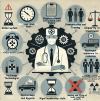Saudi Radiology Technologists' Perception of Occupational Hazards from a Personal and Social Lens
- PMID: 39493375
- PMCID: PMC11531758
- DOI: 10.2147/RMHP.S492974
Saudi Radiology Technologists' Perception of Occupational Hazards from a Personal and Social Lens
Abstract
Background: Occupational hazards among healthcare workers (HCWs) present serious risks, from infectious diseases to physical and chemical dangers, along with psychological stress, all of which threaten their health and safety. This study aims to identify the unique challenges and hazards encountered by radiology technologists in in Saudi Arabia by assessing the key factors contributing to these risks.
Methods: A descriptive questionnaire study was conducted in January-February 2023, targeting 75 radiology technologists at King Abdulaziz Medical City (KAMC), Jeddah, with participants recruited via non-probability convenience sampling and invited to complete a widely recognized questionnaire previously used among radiographers. Descriptive statistics were calculated, and the Kruskal-Wallis H-test was conducted to examine the relationships between demographic factors and different aspects of occupational hazards.
Results: Of the 75 technologists contacted, 63 responded, resulting in an 84% participation rate. Workload, work shifts, and patient-related factors are major contributors to occupational hazards, surpassing technologist-specific and organizational elements. Additionally, 68.3% cited rigid leadership and unequal treatment as aggravating factors, while insufficient staffing, inadequate protective devices, and patient interaction were also significant concerns. Over 60% identified bending, lifting heavy patients, prolonged radiation exposure, and frequent walking as major hazard sources.
Conclusion: Key occupational hazards factors facing radiology technologists include high workloads, work shifts, and patient-related issues, with 68.3% citing rigid leadership and unequal treatment as exacerbating risks. Insufficient staffing and protective devices, along with demanding work conditions, further heighten these hazards. This study emphasizes the need for targeted interventions in staffing, resources, and culture to improve radiology technologists' safety.
Keywords: Kingdom of Saudi Arabia; healthcare workers; occupational health; professional risk; radiologic technology; safety.
© 2024 Alshamrani et al.
Conflict of interest statement
The authors declare that they have no conflicts of Interest in this work.
Figures
Similar articles
-
The barriers, motives, perceptions, and attitudes toward research among radiology practitioners and interns in Saudi Arabia: a cross-sectional study.Front Med (Lausanne). 2023 Oct 9;10:1266285. doi: 10.3389/fmed.2023.1266285. eCollection 2023. Front Med (Lausanne). 2023. PMID: 37877018 Free PMC article.
-
Musculoskeletal symptoms among radiation technologists in Saudi Arabia: prevalence and causative factors.Acta Radiol. 2022 Apr;63(4):497-503. doi: 10.1177/02841851211004428. Epub 2021 Mar 28. Acta Radiol. 2022. PMID: 33779321
-
Professional practice and awareness of child abuse among radiologists and radiologic technologists: results from Saudi Arabia.Pediatr Radiol. 2023 May;53(5):832-843. doi: 10.1007/s00247-022-05561-x. Epub 2022 Dec 15. Pediatr Radiol. 2023. PMID: 36517574 Free PMC article.
-
Review of common occupational hazards and safety concerns for nuclear medicine technologists.J Nucl Med Technol. 2008 Mar;36(1):11-7. doi: 10.2967/jnmt.107.043869. Epub 2008 Feb 20. J Nucl Med Technol. 2008. PMID: 18287195 Review.
-
Nuclear Medicine Technologists' Perception and Current Assessment of Quality: A Society of Nuclear Medicine and Molecular Imaging Technologist Section Survey.J Nucl Med Technol. 2017 Jun;45(2):67-74. doi: 10.2967/jnmt.117.194704. Epub 2017 May 4. J Nucl Med Technol. 2017. PMID: 28473461 Review.
References
Grants and funding
LinkOut - more resources
Full Text Sources



